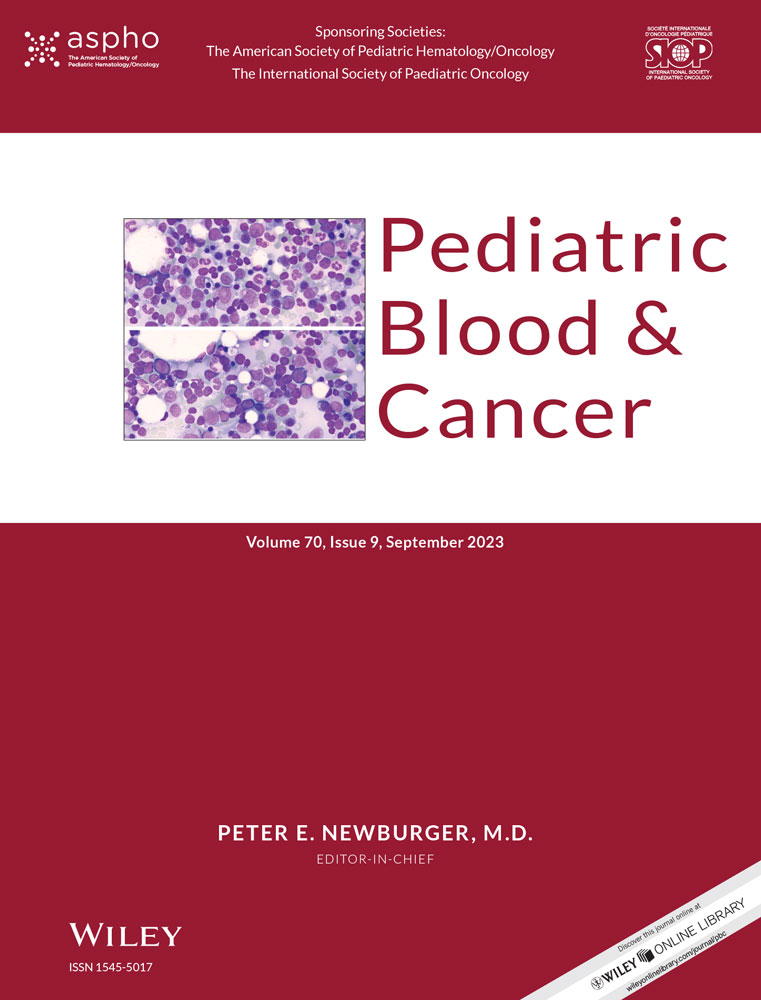Mixed-phenotype acute leukemia with BCL11B copy gain: What is the best strategy?
Keri Toner
Center for Cancer and Blood Disorders, Children's National Hospital, Washington, District of Columbia, USA
Department of Pediatrics, The George Washington University School of Medicine and Health Sciences, Washington, District of Columbia, USA
Search for more papers by this authorReuven Schore
Center for Cancer and Blood Disorders, Children's National Hospital, Washington, District of Columbia, USA
Department of Pediatrics, The George Washington University School of Medicine and Health Sciences, Washington, District of Columbia, USA
Search for more papers by this authorCorresponding Author
Jinjun Cheng
Center for Cancer and Blood Disorders, Children's National Hospital, Washington, District of Columbia, USA
Division of Pathology and Laboratory Medicine, Children's National Hospital, Washington, District of Columbia, USA
Departments of Pathology and Pediatrics, The George Washington, University School of Medicine and Health Sciences, Washington, District of Columbia, USA
Correspondence
Jinjun Cheng, Pathology and Laboratory Medicine Division, Children's National Hospital, Room 1629, 111 Michigan Avenue NW, Washington, DC 20010-2970.
Email: [email protected]
Search for more papers by this authorKeri Toner
Center for Cancer and Blood Disorders, Children's National Hospital, Washington, District of Columbia, USA
Department of Pediatrics, The George Washington University School of Medicine and Health Sciences, Washington, District of Columbia, USA
Search for more papers by this authorReuven Schore
Center for Cancer and Blood Disorders, Children's National Hospital, Washington, District of Columbia, USA
Department of Pediatrics, The George Washington University School of Medicine and Health Sciences, Washington, District of Columbia, USA
Search for more papers by this authorCorresponding Author
Jinjun Cheng
Center for Cancer and Blood Disorders, Children's National Hospital, Washington, District of Columbia, USA
Division of Pathology and Laboratory Medicine, Children's National Hospital, Washington, District of Columbia, USA
Departments of Pathology and Pediatrics, The George Washington, University School of Medicine and Health Sciences, Washington, District of Columbia, USA
Correspondence
Jinjun Cheng, Pathology and Laboratory Medicine Division, Children's National Hospital, Room 1629, 111 Michigan Avenue NW, Washington, DC 20010-2970.
Email: [email protected]
Search for more papers by this authorOpen Research
DATA AVAILABILITY STATEMENT
Data sharing not applicable to this article as no datasets were generated or analysed during the current study.
REFERENCES
- 1Khoury JD, Solary E, Abla O, et al. The 5th edition of the World Health Organization classification of haematolymphoid tumours: myeloid and histiocytic/dendritic neoplasms. Leukemia. 2022; 36(7): 1703-1719.
- 2Swerdlow SHCE, Harris NL, Jaffe ES, et al. WHO Classification of Tumours of Haematopoietic and Lymphoid Tissues. Revised 4th ed. IARC/WHO Press; 2017.
- 3Weinberg OK, Arber DA. How I diagnose acute leukemia of ambiguous lineage. Am J Clin Pathol. 2022; 158(1): 27-34.
- 4Liu Y, Easton J, Shao Y, et al. The genomic landscape of pediatric and young adult T-lineage acute lymphoblastic leukemia. Nat Genet. 2017; 49(8): 1211-1218.
- 5Meijerink JPP. BCL11B, the Cerberus of human leukemia. Blood. 2021; 138(9): 741-743.
- 6Abbas S, Sanders MA, Zeilemaker A, et al. Integrated genome-wide genotyping and gene expression profiling reveals BCL11B as a putative oncogene in acute myeloid leukemia with 14q32 aberrations. Haematologica. 2014; 99(5): 848-857.
- 7Bendig S, Stengel A, Walter W, et al. Diagnostic challenge of identifying cases with recurrent t(8;14)(q24.21;q32.2) Involving BCL11B in acute leukemias of ambiguous lineage: an analysis of eight patients. Leuk Lymphoma. 2022; 63(3): 747-750.
- 8Di Giacomo D, La Starza R, Gorello P, et al. 14q32 rearrangements deregulating BCL11B mark a distinct subgroup of T-lymphoid and myeloid immature acute leukemia. Blood. 2021; 138(9): 773-784.
- 9Montefiori LE, Bendig S, Gu Z, et al. Enhancer hijacking drives oncogenic BCL11B expression in lineage-ambiguous stem cell leukemia. Cancer Discov. 2021; 11(11): 2846-2867.
- 10Wang W, Beird H, Kroll CJ, et al. T(6;14)(q25;q32) involves BCL11B and is highly associated with mixed-phenotype acute leukemia, T/myeloid. Leukemia. 2020; 34(9): 2509-2512.
- 11Maruffi M, Sposto R, Oberley MJ, Kysh L, Orgel E. Therapy for children and adults with mixed phenotype acute leukemia: a systematic review and meta-analysis. Leukemia. 2018; 32(7): 1515-1528.
- 12Orgel E, Alexander TB, Wood BL, et al. Mixed-phenotype acute leukemia: a cohort and consensus research strategy from the Children's Oncology Group Acute Leukemia of Ambiguous Lineage Task Force. Cancer. 2020; 126(3): 593-601.
- 13Alexander TB, Gu Z, Iacobucci I, et al. The genetic basis and cell of origin of mixed phenotype acute leukaemia. Nature. 2018; 562(7727): 373-379.
- 14Cheng J, Klairmont MM, Choi JK. Peripheral blood flow cytometry for the diagnosis of pediatric acute leukemia: highly reliable with rare exceptions. Pediatr Blood Cancer. 2019; 66(1):e27453.
- 15Rasekh EO, Osman R, Ibraheem D, et al. Acute lymphoblastic leukemia-like treatment regimen provides better response in mixed phenotype acute leukemia: a comparative study between adults and pediatric MPAL patients. Ann Hematol. 2021; 100(3): 699-707.
- 16Duffield AS, Mullighan CG, Borowitz MJ. International consensus classification of acute lymphoblastic leukemia/lymphoma. Virchows Arch. 2023; 482(1): 11-26.




